News
HortiDaily: LED grow lights in NAC Breda stadium
Mid-2019 Oreon started an extensive research at football club ‘NAC Breda’ on how LED light affects a grass playing surface in combination with the unique ability to apply extracted heat directly over the grass. The research was done over the period of September 2019 to March 2020.
In cooperation with Erwin Braspenning, owner of Hubra Fieldmanagement, Oreon tested this concept during the fall and winter season in a live stadium environment.
Oreon is a developer and manufacturer of LED assimilation lights. The LED grow lights of Oreon are used in the horticulture industry (e.g. lettuce, tomatoes, microgreens and strawberries) since 2007. Due to the unique water-cooling concept of the LED fixtures, the extracted heat produced by the LEDs, can be re-used and directed to the grass.
This results in better and faster growth and the ability to illuminate the grass year-round. Together with football club ‘NAC Breda’ and Hubra Fieldmanagement, Oreon researched the benefits of using water cooled LED lighting to improve growth of grass playing surfaces in combination with a unique heating system to improve temperature control and lowering energy costs.
Why LED in sportclubs?
Artificial lights are used by sport clubs to improve the condition of the turf. Traditionally, these were high-pressure sodium fixtures (HPS). The playing surfaces used in sports are designed to withstand high amounts of activity, but the recuperation of the grass inbetween matches is often not fast enough, which results in thin patches. Which explains the need for additional light.
LED lighting is in many ways a proven step forward. A fieldkeeper has more control over growth, resulting in e.g. higher germination rates and faster root/shoot development. Furthermore, LED has many advantages over HPS: lower energy comsumption, longer life span, less heat radiation, and control over the light recipe.
Research objectives
The first research objective was 'what is the result when water cooled LED lights are used to grow high quality grass during the cold seasons of fall and winter in a stadium environment?' And the second objective was 'how can the recovered heat, derived from the water-cooling of the LED lights, effectively be applied on the grass?'
Heat application
The distribution of recovered heat derived from the LED fixtures was first tested using the standard fan speed of the heat exchanger. The fan speed was later set to a lower speed to both increase the emitted temperature and lower the flow rate to an acceptable level. Results showed that at an environmental temperature of 2°C, grass was heated to 3-4°C under LED lighting. In comparison, HPS lighting had an increase to 4-5°C under similar weather conditions. The root zone was set at a minimum of 7°C with integrated heat pipes.
Turf
The grass playing surface illuminated by LED resulted in a consistently faster closing of the turf compared to no additional lighting. The grass growth responded faster to LED lighting, resulting in better field conditions. After a sports match, Erwin has a time period of up to 6 days to return the field into optimal playing conditions. LED lighting therefore improved and accelerated the ability to improve turf conditions. According to Erwin, who before only used HPS lighting, the grass showed similar growth under LED lighting.
Roots
Roots grown under LED lighting grew to a desirable length of 9 centimers deep, resulting in less damage in between matches. This length was half the amount when no lighting was applied. Furthermore, roots illuminated by LED grew healthy white of color with significantly more branches, resulting in faster improved and sturdier field conditions.
Conclusions and future objectives
Research concluded that LED is an efficient and sustainable option for illuminating stadium grass playing surfaces, while reusing the recovered heat. In the opinion of Erwin Braspenning: The results with LED lighting were comparable with the results of lighting with HPS, in which he has years of experience. Local temperatures showed an increase under LED lighting when heat was applied when using a heat exchanger. Grass and roots grew faster and thicker compared to no lighting. Combined with a lower energy consumption we won’t be surprised to see more LED lighting in stadiums in the future. Future research will focus on the following: Adjustable light intensities and temperature settings, Improvements on heat application, Upscaling technology for similar markets.



